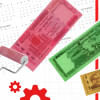Safety Net Budget Fy 2023-24: Spending just 1.01pc of GDP, not 2.52pc

On paper, Tk 126,272 crore, the amount earmarked for social safety net programmes, looks to be a hefty sum. But the sum flatters to deceive: as much as 60 percent would be going towards those not in dire need.
For instance, about 22 percent of the sum is meant to be pension for the 8 lakh government employees from grade 10 to 20. Then another Tk 11,217 crore is going as interest payment for national savings certificates.
If the agriculture subsidy and the interest subsidy for loans to small and medium enterprises, including cottage industries, are taken out, the pot becomes even smaller.
In reality, just 1.01 percent of the GDP is being spent on the poor, not the 2.52 percent of the GDP as touted by the government.

"The total allocation for social protection programmes looks quite big, but this is an inflated figure," said Selim Raihan, executive director of the South Asian Network on Economic Modelling (SANEM), a think tank.
Social safety net programmes are meant for the poor and marginalised families. "And that's why the increase in the amount for these groups is more important than the rise in the total allocation for safety net schemes," he said.
Furthermore, the allocations for the non-poor seem bloated, too. Take the case of the fund for dealing with economic and natural shocks. Some Tk 8,000 crore has been allocated for this in the incoming fiscal year, up from Tk 5,000 crore in the budget for fiscal 2022-23.
Since the fund was hardly used this fiscal year, it was hacked down to Tk 2,000 crore in the revised budget. This begs the question: Why were more funds allocated when it was hardly used in the previous year?
Besides, the government in this proposed budget created a new fund to address the health risks, allocating Tk 2,000 crore, according to the detailed document of the social safety net programme.
However, Finance Minister AHM Mustafa Kamal did not mention anything about the fund in his budget speech on the health sector. Neither did he drop a hint about the fund while announcing the budget for the social safety net schemes.
"This allocation was kept in case of any unforeseen health-related shocks like Covid-19," said a finance ministry official.
The government has set aside Tk 21,700 crore as agriculture subsidy, which is about 17 percent of the social safety net budget.
The allocation was made based on the agriculture ministry's estimation of fertiliser being used by the landless, marginal and small farmers in the country.
Agriculture subsidy and national saving certificates should be grouped under subsidy and kept out of social safety net schemes, said Raihan, also a professor of economics at the University of Dhaka.
"Such overlapping only makes the number inflated, which is confusing. Why would subsidies be included under the social safety net schemes?"
Such sectors are not included in the internationally accepted definition of social safety net, he said.
Over the years, loosely related or completely unrelated programmes that do not have anything to do with the protection of vulnerable groups have been included in the social safety net schemes, according to a review report of the Centre for Policy Dialogue titled "State of the Bangladesh Economy in FY2022-23".
Economists have been maintaining that delivering support to intended beneficiaries is the main challenge as there were previous examples of irregularities like the inclusion of ineligible beneficiaries with political connections, leaving many in need out.
"The second million-dollar question is whether the real beneficiaries are getting the government's benefits. We have to ensure that," Raihan added.


 For all latest news, follow The Daily Star's Google News channel.
For all latest news, follow The Daily Star's Google News channel. 







Comments